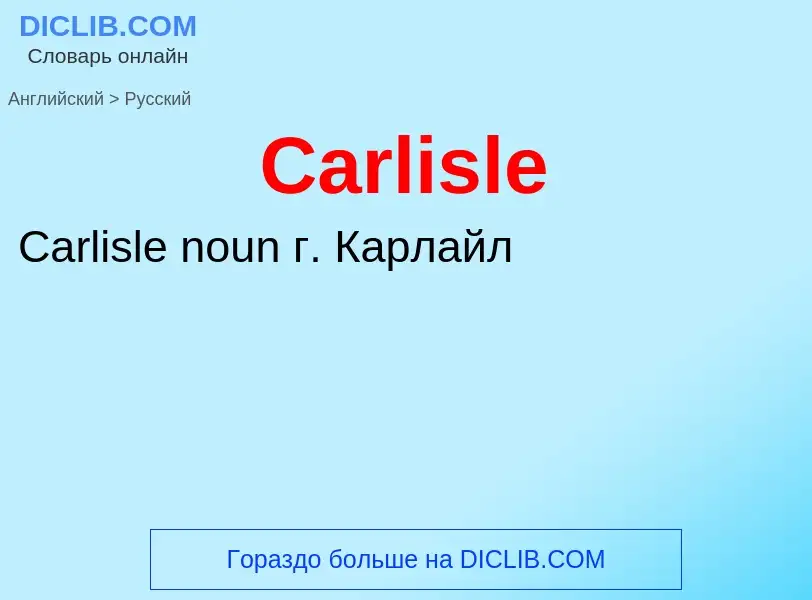ترجمة وتحليل الكلمات بواسطة الذكاء الاصطناعي
في هذه الصفحة يمكنك الحصول على تحليل مفصل لكلمة أو عبارة باستخدام أفضل تقنيات الذكاء الاصطناعي المتوفرة اليوم:
- كيف يتم استخدام الكلمة في اللغة
- تردد الكلمة
- ما إذا كانت الكلمة تستخدم في كثير من الأحيان في اللغة المنطوقة أو المكتوبة
- خيارات الترجمة إلى الروسية أو الإسبانية، على التوالي
- أمثلة على استخدام الكلمة (عدة عبارات مع الترجمة)
- أصل الكلمة
Carlisle - ترجمة إلى إنجليزي
[kɑ:'lail]
существительное
география
г. Карлайл
ويكيبيديا

Carlisle ( kar-LYLE, locally KAR-lyle; from Cumbric: Caer Luel) is a city and unparished area in Cumberland, in the ceremonial county of Cumbria, England. It is the administrative centre of the unitary authority area of Cumberland, which is named after and covers a similar area to the historic county of Cumberland.
At the confluence of the rivers Eden, Caldew and Petteril; an established settlement formed to serve forts on Hadrian's Wall in Roman Britain. There are many legends and folkloric stories about the city during the Dark Ages, such as the Sir Gawain and the Carle of Carlisle, about the nephew of King Arthur and the "free man" of the city. In the early 12th century, a priory was built and gained cathedral status with a diocese in 1133 (city status at the time meant the settlement became a city) while the county of Carlisle was created and renamed Cumberland. Carlisle Castle and the city itself was an important late-Middle Ages military stronghold against the Kingdom of Scotland, located 8 miles (13 km) south of the current Anglo-Scottish border. The castle served as a prison for Mary, Queen of Scots in 1568 and hosts the Duke of Lancaster's Regiment and the Border Regiment Museum.
In the 19th century, the introduction of textile manufacture during the Industrial Revolution began a process of socioeconomic transformation in Carlisle, which developed into a densely populated mill town. This, combined with its strategic position, allowed for the development of Carlisle as an important railway town, with seven railway companies sharing Carlisle railway station. Nicknamed the 'Great Border City', Carlisle today is the main cultural, commercial and industrial centre in the Borderlands. It is home to the main campuses of the University of Cumbria and a variety of museums and heritage centres.


![[[Brunton Park]], the home of [[Carlisle United F.C.]] [[Brunton Park]], the home of [[Carlisle United F.C.]]](https://commons.wikimedia.org/wiki/Special:FilePath/Brunton Park, Carlisle - geograph.org.uk - 1224036.jpg?width=200)
![William II]]. William II]].](https://commons.wikimedia.org/wiki/Special:FilePath/Carlisle Castle 03.jpg?width=200)
![[[Carlisle Civic Centre]] in the city centre [[Carlisle Civic Centre]] in the city centre](https://commons.wikimedia.org/wiki/Special:FilePath/Carlisle Council Offices.jpg?width=200)

![[[Carlisle railway station]] [[Carlisle railway station]]](https://commons.wikimedia.org/wiki/Special:FilePath/Carlisle railway station - Cumbria - England - 2005-06-25.jpg?width=200)
![[[Cumbria House]] [[Cumbria House]]](https://commons.wikimedia.org/wiki/Special:FilePath/Cumbria County Councils new HQ (geograph 5290723).jpg?width=200)

![m}} away during the [[Battle of Arnhem]] in the Netherlands m}} away during the [[Battle of Arnhem]] in the Netherlands](https://commons.wikimedia.org/wiki/Special:FilePath/Men waiting in ditches.jpg?width=200)

![A banknote designed by [[William Home Lizars]] for Carlisle City and District Banking Company highlights the town's industrial features. A banknote designed by [[William Home Lizars]] for Carlisle City and District Banking Company highlights the town's industrial features.](https://commons.wikimedia.org/wiki/Special:FilePath/Proof banknote designed by William Home Lizars for Carlisle City and District Banking Company, 1800s, Garratt Collection. On Display at the British Museum in London.jpg?width=200)





.jpg?width=200)

![[[Our Lady and St Joseph's Church, Carlisle]] [[Our Lady and St Joseph's Church, Carlisle]]](https://commons.wikimedia.org/wiki/Special:FilePath/Carlisle-Cumbria-1.jpg?width=200)





